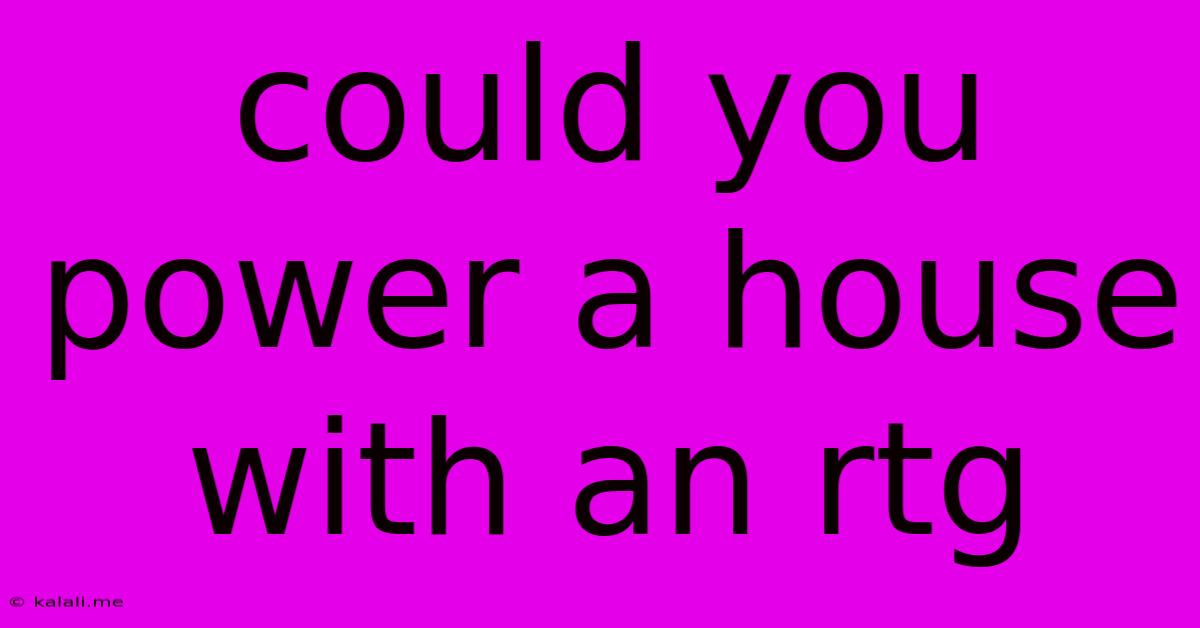Could You Power A House With An Rtg
Kalali
May 23, 2025 · 3 min read

Table of Contents
Could You Power a House with an RTG? Exploring the Feasibility of Radioisotope Thermoelectric Generators for Home Use
Meta Description: Radioisotope thermoelectric generators (RTGs) power spacecraft, but could they power a house? This article explores the feasibility, safety, cost, and environmental impact of using RTGs for residential energy.
Radioisotope thermoelectric generators (RTGs) are fascinating devices known for their role in powering spacecraft and remote installations. These devices convert the heat from radioactive decay into electricity, offering a reliable power source in locations where solar or wind energy isn't viable. But a question often arises: could you power a typical house with an RTG? The answer, while intriguing, is complex and involves weighing several crucial factors.
Understanding RTGs: How They Work and Their Limitations
RTGs utilize the heat generated by the radioactive decay of isotopes, typically plutonium-238. This heat is then used to generate electricity through a thermoelectric process. This process is remarkably efficient in converting heat energy into usable electricity, and importantly, it's continuous and doesn't rely on external factors like sunlight or wind.
However, several limitations restrict the widespread adoption of RTGs, particularly for residential use. Firstly, the sheer cost of producing an RTG is astronomical. The process involves handling highly radioactive materials, requiring specialized facilities and rigorous safety protocols, significantly driving up the expense. Secondly, the regulatory hurdles are substantial. Securing permits and adhering to strict safety regulations for handling and storing radioactive materials is incredibly challenging and expensive.
Safety Concerns and Environmental Impact
The use of radioactive materials inevitably raises safety concerns. While modern RTGs are designed with robust containment measures to prevent leakage, the potential for accidents, however small, cannot be ignored. Furthermore, the long half-life of the isotopes used requires careful long-term storage and disposal planning, adding to the overall cost and complexity. The environmental impact, including the potential for contamination and the need for secure long-term waste management, is another significant consideration.
Power Output and Energy Needs of a Typical Household
A typical household consumes a considerable amount of electricity, varying based on location, lifestyle, and appliance usage. While the power output of an RTG can be substantial, especially the larger units designed for spacecraft, it might not be sufficient to meet the energy demands of an average home. The energy output is relatively constant, meaning it might struggle to meet peak demands during periods of high energy consumption. Furthermore, scalability is a major issue; building an RTG large enough to power a house would be incredibly complex and expensive.
Alternative Energy Solutions: A More Viable Option
Given the challenges and limitations of using RTGs for residential energy, exploring more sustainable and practical alternatives is crucial. Solar panels, wind turbines, and geothermal energy offer cleaner, safer, and more cost-effective solutions for powering homes. These options have made significant strides in efficiency and affordability, making them a far more realistic choice for residential energy needs.
Conclusion: A Practical Impossibility (For Now)
While the idea of powering a house with an RTG is captivating, the practical realities present significant obstacles. The high cost, stringent safety regulations, environmental concerns, and the limited scalability of RTGs render this approach largely impractical for residential use. Focusing on readily available and sustainable energy sources remains the most efficient and responsible approach for meeting household energy demands. While RTGs remain a vital technology for specific applications, their use in powering homes is, for the foreseeable future, highly unlikely.
Latest Posts
Latest Posts
-
Expandable Group Header Sharepoint List Gallery View
May 23, 2025
-
Why Does My Cat Follow Me To The Bathroom
May 23, 2025
-
Butter My Bottom And Call Me A Biscuit
May 23, 2025
-
Adobe Font Similar To League Spartan
May 23, 2025
-
Toilet Bowl Water Not Going Down
May 23, 2025
Related Post
Thank you for visiting our website which covers about Could You Power A House With An Rtg . We hope the information provided has been useful to you. Feel free to contact us if you have any questions or need further assistance. See you next time and don't miss to bookmark.